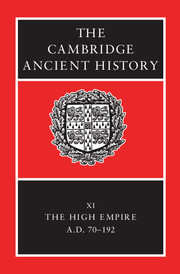Book contents
- Frontmatter
- PART I NARRATIVE
- PART II GOVERNMENT AND CIVIL ADMINISTRATION
- PART III THE EMPIRE
- PART IV ROME, ITALY AND THE PROVINCES
- 12 Rome and Italy
- 13 Spain
- 14 Gaul
- 15 Roman Germany
- 16 Africa
- 17 Cyrenaica
- 18 Britain
- 19 The Danube provinces
- 20 Greece and Asia Minor
- 21 Syria and Arabia
- 22 Judaea
- PART Va ECONOMY AND SOCIETY
- PART Vb ART AND CULTURE
- Chronological Table
- BIBLIOGRAPHY
- Index
- 1 The Roman world in the time of Marcus Aurelius
- 7 The Danube provinces
- References
17 - Cyrenaica
from PART IV - ROME, ITALY AND THE PROVINCES
Published online by Cambridge University Press: 28 March 2008
- Frontmatter
- PART I NARRATIVE
- PART II GOVERNMENT AND CIVIL ADMINISTRATION
- PART III THE EMPIRE
- PART IV ROME, ITALY AND THE PROVINCES
- 12 Rome and Italy
- 13 Spain
- 14 Gaul
- 15 Roman Germany
- 16 Africa
- 17 Cyrenaica
- 18 Britain
- 19 The Danube provinces
- 20 Greece and Asia Minor
- 21 Syria and Arabia
- 22 Judaea
- PART Va ECONOMY AND SOCIETY
- PART Vb ART AND CULTURE
- Chronological Table
- BIBLIOGRAPHY
- Index
- 1 The Roman world in the time of Marcus Aurelius
- 7 The Danube provinces
- References
Summary
The account of geographical and social conditions in Cyrenaica, its Augustan organization and Julio-Claudian development given in CAH X2 619–40 is taken for granted here. What happened during the ‘Year of the Four Emperors’ is not known. It would be surprising, however, if the Greek élite was unaffected by the fall of Nero, with whom some members seem to have had influence, or by the events in Egypt which made an emperor of Vespasian, once quaestor of Crete and Cyrene; while the Jewish communities, always in touch with Judaea, must have reacted to the course of the revolt there. When the proconsul Antonius Flamma (who may have been a Cyrenaean (CAH X2 637–8) was condemned in 70 for extortion aggravated by cruelty, the sentence may have reflected the factional politics of the period as much as his guilt.
For the following century and a quarter we have only gobbets of information. They derive from literary, epigraphic and archaeological sources to approximately the middle second century, from epigraphic and archaeological, with one important papyrological supplement, thereafter. The dating and interpretation of these items is often open to argument; received doctrines are very liable to be controverted by new discoveries; like that in CAH X2, this account is strictly provisional.
- Type
- Chapter
- Information
- The Cambridge Ancient History , pp. 547 - 558Publisher: Cambridge University PressPrint publication year: 2000
References
- 2
- Cited by



